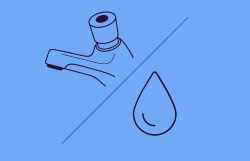In opening the water market and giving us the option to chose our own supplier, many businesses have been left confused, unaware of what their options are, and find themselves overpaying for their supply as a result. While it is a necessity to have consistent water flow through your business, many are paying above and beyond for this essential service.
There are a number of options for you to reduce your business costs, with switching being in the lead option for many. Still, there is a lack in information for those looking to make this change. In this guide, we look to bring these sources together with the goal of helping you decide the best option for your business water and sewage supply.
Suppliers
Water suppliers who may be interested in working with your business can be split into two groups, one that was created from the old regional water authorities and existed before the deregulation of our market, and those who could be considered new entries to that market. While suppliers that were comfortable with the regional authorities generally kept their company names, such as Anglian Water, they remain responsible for the water infrastructure in their respective ovations, as they tend to be much larger companies, and hold a higher stake in the market than the likes of new entrants, and are overpowering to those in terms of the number of staff and clients.
The largest water supply business in England is Water Plus, with an estimate of 400,000 customers. Founded in 2016, they were a joint venture between two companies United Utilities and Severn Trent, followed shortly after by Castle Water, with over 350,000 customers estimated to be in contract with them.
In Scotland’s non-domestic sector, Business Stream are the leading company to be found and hold a significant share of the market in England, too.
Wave were founded in 2008 in Scotland from the previous name Anglian Water. They have followed on to business in England’s deregulated market since 2017 and claim to have over 300,000 customers across the UK.
Everflow was born of Josh Gill in 2014, and initially targeted the Scottish market, like many other suppliers brought into play at that time. They are considered a true success story of market deregulation due to not being born from the likes of former suppliers Water Plus or Castle, and instead fought their way through the industry into where they are today.
United Utilities is not a business that holds the title of the regional water authority, despite being brought into the market in 1995 as a descendant of North West Water. Water2business was a merger between Bristol Water and Wessex Water in 2000.
How does the water market differ from the energy market?
Some of the key differences between utility sectors is that the water market operates on a domestic level. Like most markets, the water market means that retailers must purchase their water from a wholesaler offering this to businesses at competitive rates, but where energy can be imported from abroad, water in the United Kingdom is sourced and procured within the countries borders. In the UK, we often naturally source water from rainwater, so that there is no importing involved.
In England, though, regulators of the wholesale market has been fixed until April of 2020. This means that customers can expect more stability in their payment rates and smaller marginal differences. This is a perfect opposite of the constantly fluctuating electricity market.
The likes of the energy industries overpowering business leads such as British Gas is not seen to be matched in the water industry, with a healthier challenge between competing suppliers. Currently, the water market in the UK is only open to domestic business customers, though the benefits of household customers has the potential to encourage the market to be extended in the future.
Who controls the water market?
Our water market is currently monitored by a number of organisations that differ depending on the country. In England, there are three regulators watching over the open market;
Defra – the Department for the Environment, Food, and Rural Affairs.
Ofwat – an economic regulator and licensing authority.
MOSL – a Market Operator that ensures the market remains simple and efficient.
In Scotland, the Water Industry Commission (WICS) is responsible for regulating the water market.
Why must a business pay for water services?
The cost of water services is built from a number of cycles needed in order to filter, treat and deliver your water for safe use. Water is then disposed of or recycled, involving further treatment process that is not cheap. Alongside this, there is maintenance involved the supply networks and treatment facilities that do this work for us, and they require funding to be kept up to date.
Who do I buy my water from?
As a business, you must buy your water room a licensed supplier. Your supplier must be licensed by Ofwat in England and the WICS in Scotland, who as explained above, are the economic regulators of their respective water markets. Currently in the UK, there are only 25 water retailers to chose from.
The wholesalers that we purchase water and wastewater services from are responsible for operating the network of pipes, mains and treatment works that ensure a smooth running of our water services. The wholesaler that your location uses will be dependant on the region you operate in.
It is the retailers who are responsible for bill handling, maintaining up to date meter readings and providing customer service. A retailer will pay the same price per unit of water, but will alter the price and services offered to customers depending on their business’ circumstances and needs.
Who is eligible to buy a business water supply?
Any non-household organisation that pays business rates is welcome to chose their business water market. This in exclusive to businesses, and includes charities, schools and NHS trusts.
Supply Standards
How is my business connected to the water network?
Water mains move water around the entire network, and are often laid under highways.
Communication pipes are used to move water between the water mains and the property they are supplying. Your stop tap (if you have one) will indicate the end of the pipe work your property is responsible for.
Supply pipes carry water from the cost of your premises into your building, and are the smaller pipes you may see.
It is also possible to explain the network that takes waste water from your business, in three simple area.
Public sewers take waste water and surface water from more than one property, and to a centre for treatment.
Drains carry your water to the sewer from your property.
Private sewers collect and carry waste through pipes from several properties, to be treated by a water company.
Who is responsible for maintaining pipes and sewers?
Pipes are a shared responsibility between the water supplier, and the owner of the property. This is because the water companies are responsible for pipes leading up to the boundary of your property, including maintenance and communication pipes, alongside mains where leaks, repairs or replacements may become an issue. In contrast, your business will be responsible for pipes, drains and plumbing fixtures leading to your property. This boundary is often marked by a company stop tap.
A business and property owner also shares responsibility for sewers and drains; the sewage company is responsible for public sewers that are often found under public roads, gardens, and other spaces, whereas a property owner is responsible for the drains that carry their own waste to public sewers. The end of a business’s responsibility is often shown by a manhole cover.
In England, Highway Agencies have the potential to be responsible for maintaining some drains found on or under a highway.
What am I responsible for?
| You | The water company | Additions |
| Pipes from the boundary of your property to the inside of your building | Pipes leading up to the boundary of your property | This includes maintenance; leaking, repairs replacements. |
| Drains that carry your own properties waste to public sewers. | Pipes and sewage that is often placed under public spaces. | The mark made to show where the responsibility is cut off for each individual is marked by a manhole cover. |
| Ensuring that high water pressure does not damage your business if your own fittings are up to standard |
How can my business connect to the water mains?
Business water is supplied for both domestic and non domestic purposes, like washing and sanitisation, as well as for commercial purposes. For domestic water users, the cost of any reasonable extensions and connections should be covered by your supplier. If this becomes a dispute, then a deposit might be applied by the supplier to fit the new equipment.
For non-domestic water uses, you should be held responsible for any costs required for connecting. It is required of you to come to an agreement with your supplier to make sure that they have the means to meet your needs. If there is not already a possible connection in your building’s premesis, then this may need to be extended to the mains.New connections to your existing supply will need to be covered by the owner of the property you work from.
When it comes to connecting the new property, this will involve infrastructure changes that cover the cost of extending a distribution network, and making the request to do this will involve a requisition charge. This is charged by the water company to provide the main.
What is water pressure, and why is it important?
Water pressure is the given name to the pressure needed to push your water through the pipes and out of your taps. The amount of pressure is what determines the flow of water as it leaves your taps, meaning that high pressure would equal a higher flow rate, still, both high and low water pressure can be dangerous, so we need this to be just right.
There are a number of factors that could affect your water pressure, such as the height of your premises and the service reservoir in relation to this. Low pressure has the potential to lead to a trickle from your tap, and can make some processes take twice as long. This can be caused by high demand, inadequate facilities or faulty pipes. In contrast, high pressure can damage the plumbing that you are responsible for and cause flooding as an extreme example. Otherwise, it is often caused reconfiguration of supply networks due to air trapped inside the pipe.
Some appliances may need a higher or lower water pressure to function properly, which may be specifically seen in industrial sectors, and so it may be worth contacting a supplier to ask if they can cater to these operations in your specific area.
In England, the guaranteed standards scheme (GSS) states that water companies must do to “maintain a minimum pressure in the communication pipe of seven enters static head”. If a water company does not meet this minimum twice within a 28 day period, they will be forced to pay a fee to the consumer as compensation.
My water pressure is low, what should I do?
1. Perform a stop tap test to check for a leak
2. Contact your supplier who will be able to determine where the issue is located
Interested in cutting your water bills down to size? Get in touch with our Business Water Team today.



